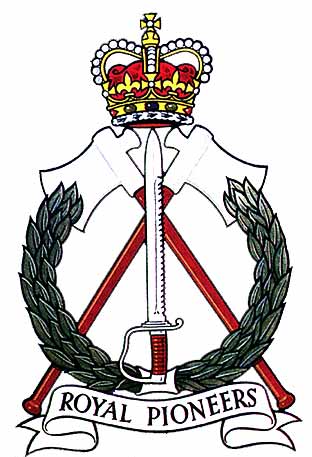|
With World War 2 at an end, the Corps
along with the rest of the Armed Forces, began to reduce in
size as the Age and Service Demobilisation Scheme got underway.
The Corps gained many awards for gallantry
and in addition received American, French, Dutch, Greek, Belgian
and Italian awards. Some 2,800 men of the Corps laid down
their lives oversees and 6000 other nationalities serving with the Corps lost their lives during World War II.
In the immediate postwar period the future of the Royal Pioneer
Corps came under discussion on several occasions. At a meeting
held at the War Office in February 1948 it was decided that
the Corps should not form part of the permanent postwar Active
Army. However, on 8 October of that year, it was decided that
intake in the Corps should continue until at least March 1950.
Although the Corps had reduced considerably in size by this
time, (the Pioneers of the High Commissioned Territories Corps,
after excellent service, had been disbanded) we were still
a large Corps with far-flung responsibilities.
The strength of the UK element was :-
650 Officers
900 Soldiers serving on regular engagements
400 Soldiers serving on short service regular engagements
7800 National Service Solders
In addition, the strength of
the Mauritian Royal Pioneers was
14,000
In BAOR the Labour Directorate was
responsible for the recruitment and administration of 251,000
civilians employed by the Forces. In Egypt the Corps administered
the 48,000 civilians employed there. It was about this time
the Bastyan Committee on the future of the British Army came
into being. Its basic terms of reference being to make recommendations
concerning the composition and size of the postwar Regular
Army. On 4 May 1949 Brigadier
H H Blanchard CBE, Director of Pioneers and Labour presented
a paper on the Royal Pioneer Corps to this Committee. A copy
of this paper is held in the Royal Logistics Museum at Deepcut
and in the Brigadier's own hand is inscribed :-
'This was
the first move which resulted in the Corps becoming part of
the Regular Army'.
In February 1950 the Royal Pioneer Corps became
part of the Regular Army. Since
the end of World War 2, Royal Pioneer Corps officers and soldiers
have played their part in all operations overseas.
A proposal to change the badge of the Corps to reflect its changing role received the concurrence of the Colonel-in-Chief, His Royal Highness The Duke of Gloucester, who made a major contribution to the design. Following consultation with, and the agreement of, Garter King of Arms the design of the new badge was submitted to, and approved by, Her Majesty The Queen in March 1984. The description is:- Two Pioneer axes crossed in saltire beneath their heads and surmounted of a Pioneer Sword and a laurel wreath below the same scroll inscribed Royal Pioneers and the whole ensigned by a Royal Crown all argent. By removing the pick and shovel of the badge the outdated image of labouring is eradicated; instead, the inclusion of the axes and sword is both traditional and symbolic of the skills required by members of the Corps in discharging their military role.
 Rebadging Parade Programme - 13th February 1985 Simpson Barracks, Northampton Rebadging Parade Programme - 13th February 1985 Simpson Barracks, Northampton

• The
second cap badge of the Royal Pioneer Corps
|
